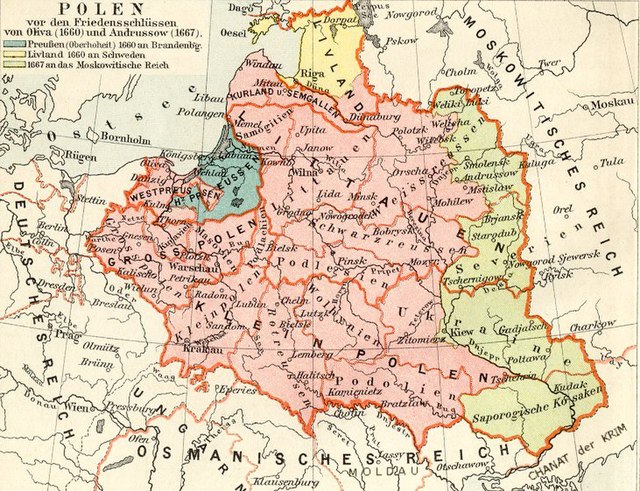Kiev Voivodeship
Subdivision of the Grand Duchy of Lithuania and the Kingdom of Poland From Wikipedia, the free encyclopedia
The Kiev Voivodeship[1] (Polish: Województwo kijowskie; Latin: Palatinatus Kioviensis; Ukrainian: Київське воєводство, romanized: Kyivske voievodstvo) was a unit of administrative division and local government in the Grand Duchy of Lithuania from 1471 until 1569 and of the Crown of the Kingdom of Poland from 1569 until 1793, as part of Lesser Poland Province of the Polish Crown. On some maps Kiev Voivodeship was also named as the Lower Volhynia.
| Kiev Voivodeship | |||||||||||
|---|---|---|---|---|---|---|---|---|---|---|---|
| Voivodeship of Polish–Lithuanian Commonwealth¹ | |||||||||||
| 1471–1793 | |||||||||||
 The Kiev Voivodeship in the Polish–Lithuanian Commonwealth in 1635. | |||||||||||
| Capital | (Kijów (Kyiv), 1471–1667), Żytomierz (Zhytomyr, 1667–1793) | ||||||||||
| Demonym | Kievan | ||||||||||
| Area | |||||||||||
• 1793 | 200,000 km2 (77,000 sq mi) | ||||||||||
| Population | |||||||||||
• 1793 | 500,000 | ||||||||||
| Government | |||||||||||
| Voivode | |||||||||||
• 1471–1475 | Martynas Goštautas (first) | ||||||||||
• 1559–1608 | Konstanty Wasyl Ostrogski (transition) | ||||||||||
• 1791–1793 | Antoni Protazy Potocki (last) | ||||||||||
| History | |||||||||||
• death of Simeon Olelkovich | 1471 | ||||||||||
• 2nd Muscovite–Lithuanian War | 1503 | ||||||||||
| 1569 | |||||||||||
| 1648 | |||||||||||
| 1667 | |||||||||||
| 1793 | |||||||||||
| Political subdivisions | counties:
| ||||||||||
| |||||||||||
| Today part of | Ukraine, partially Belarus | ||||||||||
| ¹ Voivodeship of the Kingdom of Poland. The kingdom was part of the Polish–Lithuanian Commonwealth from 1569. | |||||||||||




The voivodeship was established in 1471 upon the death of the last prince of Kiev Simeon Olelkovich and transformation of the Duchy of Kiev (appanage duchy of the Grand Duchy of Lithuania) into the Voivodeship of Kiev.
Description
The voivodeship was established in 1471 under the order of King Casimir IV Jagiellon soon after the death of Semen Olelkovich. It had replaced the former Principality of Kiev, ruled by Lithuanian-Ruthenian Olelkovich princes (related to House of Algirdas and Olshansky family).[2][3]
Its first administrative center was Kiev, but when the city was given to Imperial Russia in 1667 by Treaty of Andrusovo, the capital moved to Zhytomyr (Polish: Żytomierz), where it remained until 1793.
It was the biggest voivodeship of the Polish–Lithuanian Commonwealth by land area, covering, among others, the land of Zaporizhian Cossacks.
Municipal government
The governor of the voivodeship was voivode (List of voivodes of Kiev).[4] In the Polish–Lithuanian Commonwealth the other two major administrative positions were castellan[5] and bishop (biskup kijowski).
- List of voivodes of Kiev
- Castellan of Kijow (city governor)
- Vogt of Kijow
Flag and coat of arms
The flag on one side had Lithuanian Pogon on red field and on other side black bear on white field with his front left paw raised up.[6]
Regional council (sejmik)
Regional council (Polish: sejmik generalny) for all Ruthenian lands
Regional council (Polish: sejmik poselski i deputacki) seats
Administrative division
Counties
- Kijow County, Kijow (Biała Cerkiew, Bila Tserkva, since 1659)
- Owrucz County, Owrucz
- Żytomierz County, Żytomierz
Other former counties
- Putywl County, Putywl (lost after the second Muscovite–Lithuanian War)
- Mozyrz County, Mozyrz (transferred to Minsk Voivodeship under the Union of Lublin)
- Czerkasy County, Czerkasy (liquidated in 1566)
- Czarnobyl County, Czarnobyl (liquidated in 1566)
Former counties lost under the Treaty of Andrusovo
Elderships (Starostwo)
Instead of some liquidated counties in 1566 there were established elderships: Biała Cerkiew, Kaniów, Korsun, Romanówka, Czerkasy, Czigrin.
Free royal cities
Neighbouring Voivodeships and regions

See also
References
Sources
Further reading
External links
Wikiwand - on
Seamless Wikipedia browsing. On steroids.

